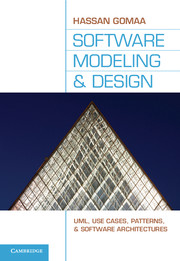Book contents
- Frontmatter
- Contents
- Preface
- Annotated Table of Contents
- Acknowledgments
- PART I Overview
- 1 Introduction
- 2 Overview of the UML Notation
- 3 Software Life Cycle Models and Processes
- 4 Software Design and Architecture Concepts
- 5 Overview of Software Modeling and Design Method
- PART II Software Modeling
- PART III Architectural Design
- PART IV Case Studies
- Appendix A Catalog of Software Architectural Patterns
- Appendix B Teaching Considerations
- Glossary
- Answers to Exercises
- Bibliography
- Index
5 - Overview of Software Modeling and Design Method
from PART I - Overview
Published online by Cambridge University Press: 05 June 2012
- Frontmatter
- Contents
- Preface
- Annotated Table of Contents
- Acknowledgments
- PART I Overview
- 1 Introduction
- 2 Overview of the UML Notation
- 3 Software Life Cycle Models and Processes
- 4 Software Design and Architecture Concepts
- 5 Overview of Software Modeling and Design Method
- PART II Software Modeling
- PART III Architectural Design
- PART IV Case Studies
- Appendix A Catalog of Software Architectural Patterns
- Appendix B Teaching Considerations
- Glossary
- Answers to Exercises
- Bibliography
- Index
Summary
The software modeling and design method described in this book is called COMET (Collaborative Object Modeling and Architectural Design Method), which uses the UML notation. COMET is an iterative use case–driven and object-oriented method that specifically addresses the requirements, analysis, and design modeling phases of the software development life cycle. This chapter considers the COMET method from a software life cycle perspective. The development process for the COMET method is a use case–based software process, which is compatible with the Unified Software Development Process (USDP) (Jacobson, Booch, and Rumbaugh 1999) and the spiral model (Boehm 1988). This chapter presents the COMET use case–based software life cycle and describes how the COMET method may be used with the USDP or the spiral model. It then outlines the main activities of the COMET method and concludes with a description of the steps in using COMET.
Section 5.1 describes the COMET use case–based software life cycle, and Section 5.2 compares COMET with other software processes. Section 5.3 gives an overview of the requirements, analysis, and design modeling activities in COMET. Section 5.4 gives an overview of the design of different kinds of software architectures covered in this textbook.
COMET USE CASE–BASED SOFTWARE LIFE CYCLE
The COMET use case–based software life cycle model is a highly iterative software development process based around the use case concept. In the requirements model, the functional requirements of the system are described in terms of actors and use cases.
- Type
- Chapter
- Information
- Software Modeling and DesignUML, Use Cases, Patterns, and Software Architectures, pp. 61 - 68Publisher: Cambridge University PressPrint publication year: 2011



